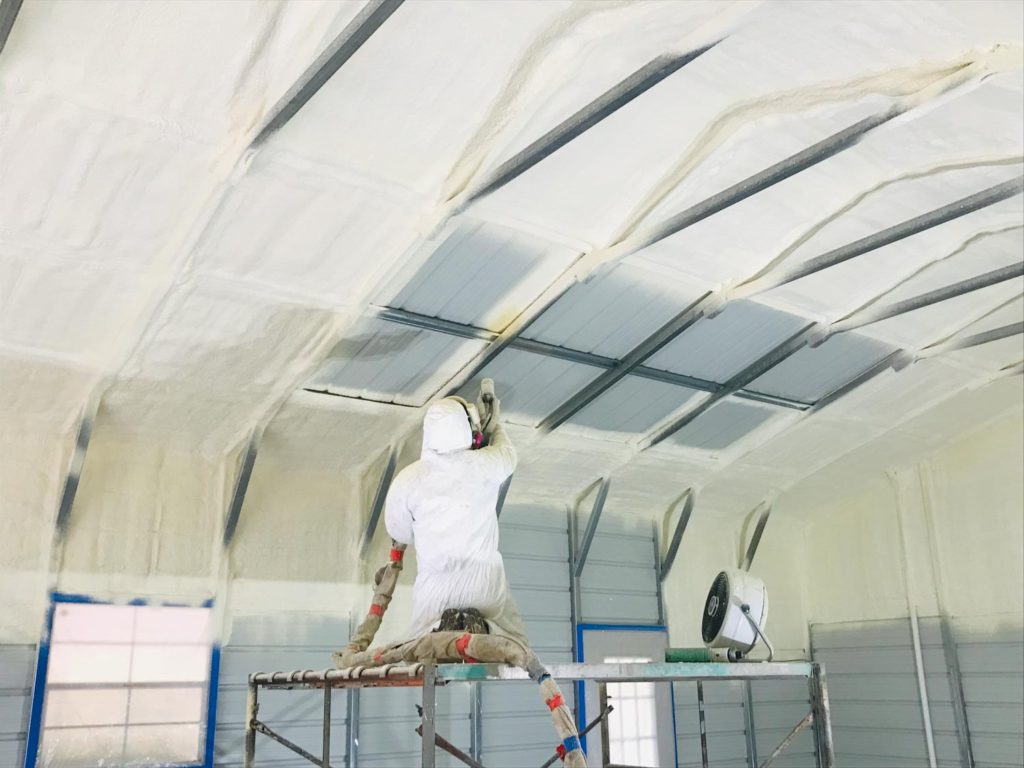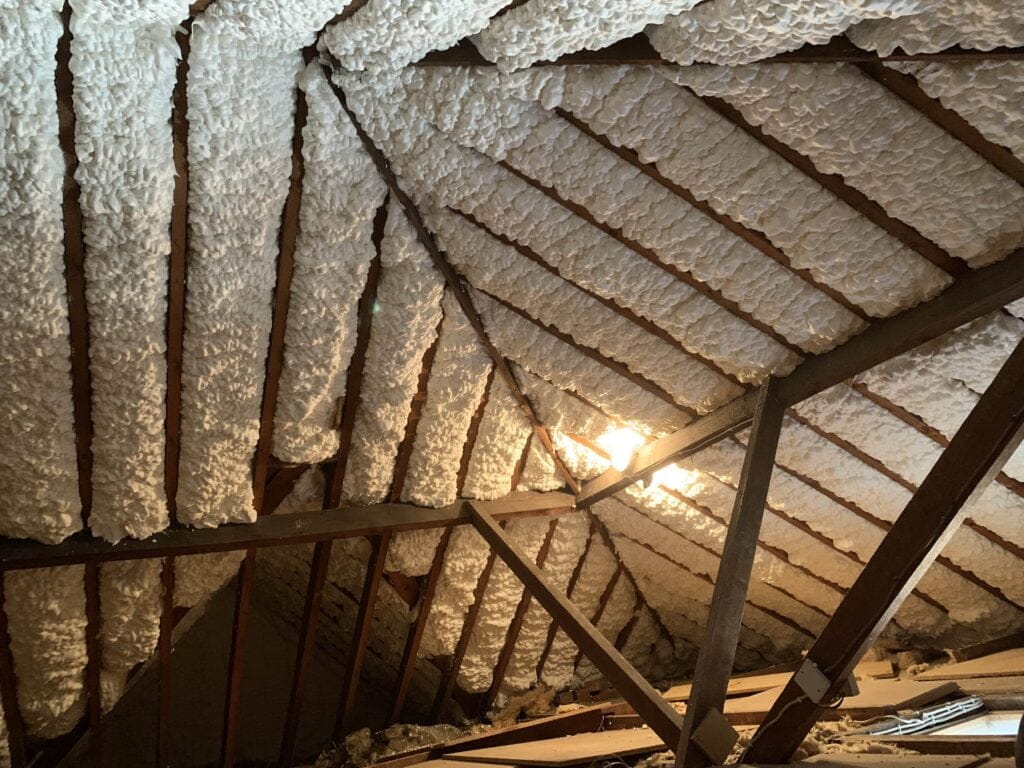Spray Foam: The Ultimate Solution for Air Sealing and Insulation
Spray foam insulation has emerged as a leading remedy for efficient air sealing and thermal insulation, offering a special mix of buildings that set it apart from traditional methods. Comprehending the complete scope of its advantages, installation processes, and contrasts with various other insulation kinds is important for making notified decisions.
What Is Spray Foam?
Spray foam is a flexible insulation material that combines the principles of air sealing and thermal resistance to enhance energy effectiveness in buildings. Made up largely of polyurethane or various other similar substances, spray foam is applied as a fluid that broadens upon contact with surface areas, producing a solid, continual layer of insulation. This distinct building allows it to load voids, fractures, and spaces that conventional insulation products may overlook, offering a superior air seal.
There are 2 main sorts of spray foam: open-cell and closed-cell. Open-cell spray foam is lighter and more flexible, using outstanding noise absorption and a lower R-value per inch - Spray Foam. In contrast, closed-cell spray foam is denser, giving a greater R-value, dampness resistance, and added architectural honesty to constructing parts
The application procedure generally includes specialized tools, making certain a smooth application that complies with different substratums, including metal, concrete, and wood. This flexibility makes spray foam ideal for both brand-new building and constructions and retrofitting existing frameworks. Its ability to create an impermeable obstacle substantially contributes to lowering energy intake and boosting interior air high quality, therefore making it a recommended choice amongst house owners and contractors alike.
Advantages of Spray Foam Insulation
One of one of the most significant benefits of spray foam insulation is its exceptional ability to produce a constant air barrier, which effectively minimizes energy loss. Unlike standard insulation materials, spray foam expands to fill up fractures and voids, guaranteeing that air leak is significantly decreased. This particular not just improves power effectiveness yet likewise results in lower energy costs gradually.
In addition, spray foam insulation gives superior thermal resistance, adding to a much more stable indoor setting. Its high R-value per inch enables efficient insulation in restricted areas, making it suitable for attics, wall surfaces, and crawl areas. Moreover, the moisture-resistant properties of spray foam assistance stop mold and mildew and mildew development, advertising healthier living conditions.
An additional crucial benefit of spray foam insulation is its sound-dampening qualities (Spray Foam). It efficiently reduces noise transmission between rooms, creating a quieter and much more comfortable home setting. The durability of spray foam also sticks out, as it does not sag or clear up in time, keeping its performance throughout its life expectancy
How Spray Foam Works
Understanding exactly how spray foam insulation works is important for appreciating its performance in air securing and thermal resistance. Spray foam insulation consists of 2 main components: isocyanate and polyol resin. When these parts are combined, they undertake a chemical response that causes the material to increase rapidly, creating a dense foam that loads splits, dental caries, and voids.
As the foam increases, it complies with surfaces, creating a closed seal that dramatically lowers air infiltration. This characteristic makes spray foam insulation very reliable at avoiding drafts and dampness penetration, which can lead to energy loss and damage in time. Additionally, the closed-cell version of spray foam uses exceptional thermal resistance because of its rigid framework, properly reducing warmth transfer.
The one-of-a-kind homes of spray foam enable it to comply with uneven surfaces, making certain extensive coverage and a seamless barrier. Because of this, spray foam insulation not just improves power performance yet likewise contributes to boosted interior air high quality by lowering the build-up of toxins and irritants. Inevitably, recognizing the technicians behind spray foam highlights its role as a premium option for insulation and air sealing in both commercial and residential applications.
Installment Process Review

Before installation, the area should be effectively cleaned up and prepped, making certain that surface areas are devoid of dirt, moisture, and debris. Since contaminants can compromise attachment and total efficiency, linked here this action is important. Once the location is prepared, the application involves mixing both elements of the spray foam, which broadens upon call and loads spaces successfully.
Trained experts must carry out the installation, using specific devices to make certain consistent protection and optimum thickness. Safety and security safety measures, consisting of wearing safety equipment and ensuring appropriate ventilation, are essential throughout this procedure. After application, the foam normally cures swiftly, forming a solid barrier that enhances energy effectiveness.
Comparing Spray Foam to Conventional Insulation
When examining insulation options, spray foam insulation stands out in contrast to traditional products such as fiberglass and cellulose. One of the primary advantages of spray foam is its superior air sealing capacities. Unlike fiberglass and cellulose, which can permit air seepage, spray foam expands upon application, filling voids and holes to develop an impermeable seal. This results in improved power effectiveness, as less warmed or cooled down air runs away the home, leading to reduced utility bills.
In addition, spray foam supplies a greater R-value per inch than typical insulation types, using even more reliable thermal resistance in a thinner account. This particular is specifically useful in rooms with limited dental caries depth. Furthermore, spray foam is immune to moisture and mold and mildew growth, which can be a considerable problem with cellulose and fiberglass, especially in damp settings.
Nonetheless, spray foam insulation commonly carries a higher upfront expense than its traditional equivalents. Property owners must consider this preliminary financial investment against long-lasting power cost savings and performance advantages. Inevitably, while both insulation types offer their purpose, spray foam emerges as a more advanced option for modern-day insulation demands, particularly in regards to air securing and thermal performance.

Verdict
In recap, spray foam insulation represents a very reliable read more solution for accomplishing optimum air sealing and thermal resistance. Its unique buildings, consisting of moisture resistance and sound dampening, make it ideal for different applications in both new buildings and retrofitting projects (Spray Foam). Although the preliminary costs may be greater compared to standard insulation materials, the long-lasting advantages, such as significant energy savings and enhanced indoor air high quality, warrant the investment and emphasize its worth in modern-day structure methods.
Spray foam insulation has emerged as a leading solution for reliable air sealing and thermal insulation, using an one-of-a-kind combination of homes that establish it apart from typical methods.Spray foam is a functional insulation material that combines the principles of air securing and thermal resistance to enhance energy effectiveness in structures.When evaluating insulation alternatives, spray foam insulation stands out in comparison to conventional materials such as fiberglass and cellulose. Ultimately, while both insulation types offer their function, spray foam arises as a much more sophisticated option for modern insulation demands, specifically in terms of air securing and thermal effectiveness.
In summary, spray foam insulation represents a very effective solution for attaining optimum air sealing and thermal resistance.